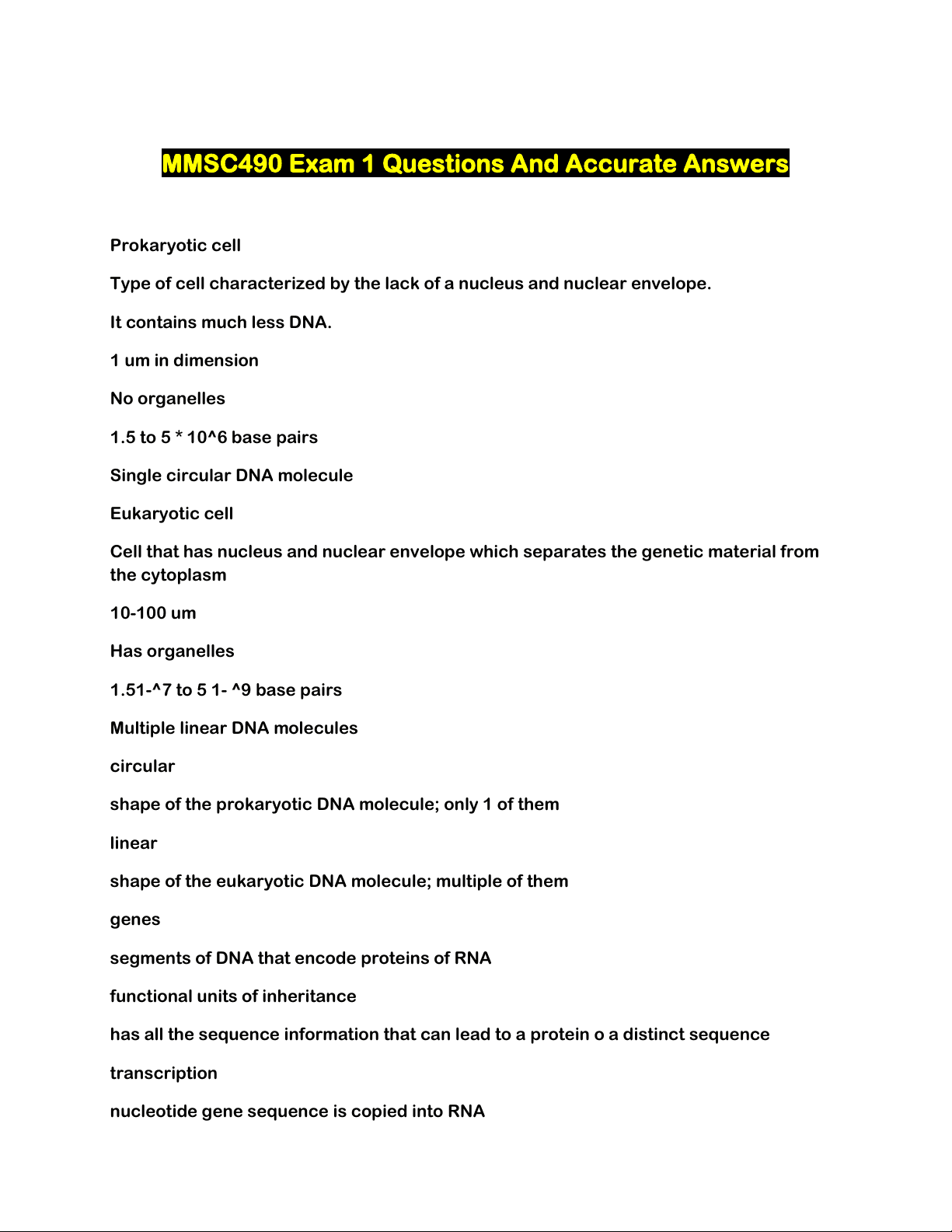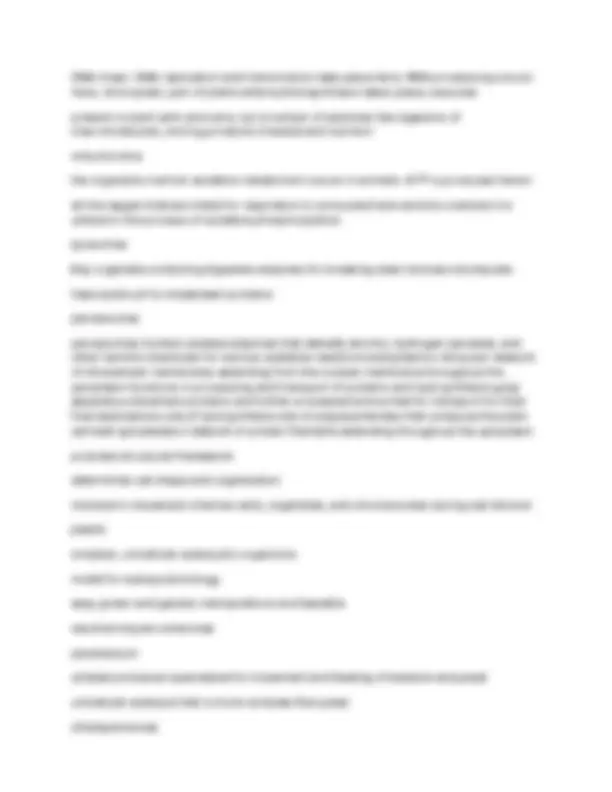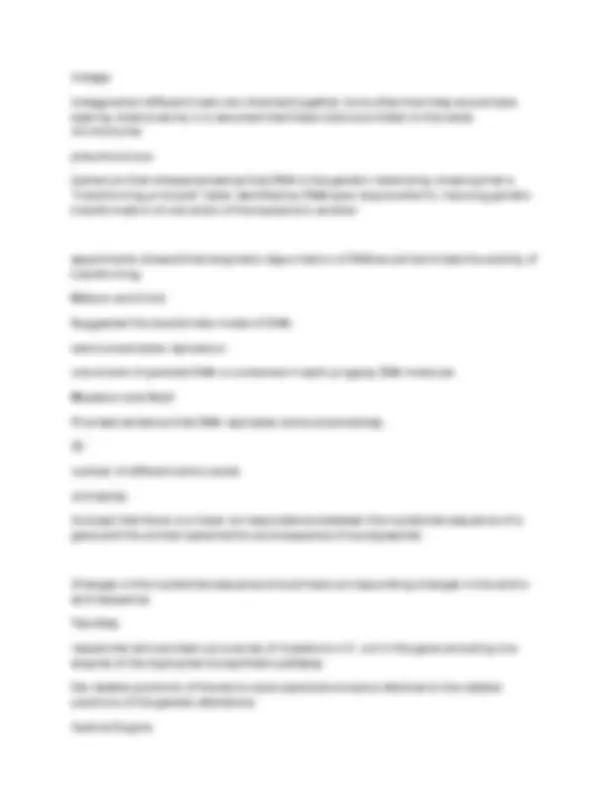





























Study with the several resources on Docsity

Earn points by helping other students or get them with a premium plan


Prepare for your exams
Study with the several resources on Docsity

Earn points to download
Earn points by helping other students or get them with a premium plan
Community
Ask the community for help and clear up your study doubts
Discover the best universities in your country according to Docsity users
Free resources
Download our free guides on studying techniques, anxiety management strategies, and thesis advice from Docsity tutors
This overview covers core cell biology concepts, contrasting prokaryotic and eukaryotic cells, and detailing cellular component functions. Key topics include DNA structure, protein synthesis, ATP production, and organelle roles (mitochondria, lysosomes, endoplasmic reticulum). It introduces model organisms like bacteria, yeast, C. elegans, and Drosophila melanogaster. Light and fluorescence microscopy principles are explained, including resolution, numerical aperture, and image deconvolution. This serves as a study aid for cell and molecular biology students, summarizing essential concepts and techniques, particularly useful for exam preparation with clear definitions and explanations.
Typology: Exams
1 / 35

This page cannot be seen from the preview
Don't miss anything!




























Prokaryotic cell Type of cell characterized by the lack of a nucleus and nuclear envelope. It contains much less DNA. 1 um in dimension No organelles 1.5 to 5 * 10^6 base pairs Single circular DNA molecule Eukaryotic cell Cell that has nucleus and nuclear envelope which separates the genetic material from the cytoplasm 10-100 um Has organelles 1.51-^7 to 5 1- ^9 base pairs Multiple linear DNA molecules circular shape of the prokaryotic DNA molecule; only 1 of them linear shape of the eukaryotic DNA molecule; multiple of them genes segments of DNA that encode proteins of RNA functional units of inheritance has all the sequence information that can lead to a protein o a distinct sequence transcription nucleotide gene sequence is copied into RNA
translation nucleotide sequence of RNA is used to specify the order of amino acids in a protein phospholipids the component of all present day biological membranes spontaneously form the membrane when placed in water two fatty acids joined to a polar head amphipathic having both a hydrophilic region and a hydrophobic region hydrophobic water-insoluble; describes chains of phospholipids hydrophilic water-soluble; describes the head groups of phospholipids lipid bilayer structure of biological membranes thats forms when the tails of lipids interact with each other and the heads interact with water RNA the primordial nucleic acid that mades up early organisms encapsulated in the phospholipid bulater ATP main energy source that cells use for most of their work and metabolism has a tri-phosphate group on the 5' end that has an alpha to beta bond and a beta to gamma bond that are both very high energy when ATP is hydrolyzed to ADP and phosphate the beta-gamma bond breaks and release 7.5 kcal/mol of energy beta-gamma this is the name for the bond that breaks when ATP is hydrolyzed to ADP and phosphate 7.5 kcal/mol the amount of energy released when ATP is hydrolyzed
DNA linear; DNA replication and transcription take place here; RNA processing occurs here; chloroplast; part of plants where photosynthesis takes place; vacuoles present in plant cells and carry out a number of activities like digestion of macromolecules, storing products of waste and nutrition mitochondria the organelle in which oxidative metabolism occurs in animals. ATP is produced herein all the oxygen that we inhale for respiration is consumed here and this is where it is utilized in the process of oxidative phosphorylation lysosomes Any organelle containing digestive enzymes for breaking down biomacromolecules have acidic pH to breakdown proteins peroxisomes peroxisomes Contain oxidase enzymes that detoxify alcohol, hydrogen peroxide, and other harmful chemicals for various oxidative reactions endoplasmic reticulum network of intracellular membranes extending from the nuclear membrane throughout the cytoplasm functions in processing and transport of proteins and lipid synthesis golgi apparatus site where proteins are further processed and sorted for transport for their final destinations site of lipid synthesis site of polysaccharides that compose the plant cell wall cytoskeleton network of protein filaments extending throughout the cytoplasm provides structural framework determines cell shape and organization involved in movement of whole cells, organelles, and chromosomes during cell division yeasts simplest, unicellular eukaryotic organisms model for eukaryote biology easy grown and genetic manipulations are feasable saccharomyces cerevisiae paramecium ciliated protozoan specialized for movement and feeding of bacteria and yeast unicellular eukaryot that is more complex than yeast chlamydomonas
unicellular green algae that can carry out photosynthesis w/ chloroplasts multicellular algae Represent the evolutionary transition from single cells to multicellular organisms which was an important event
ex is volvex epithelial cells Cells that cover the surface of the body and line internal organs connective tissues Tissue that makes up bone, cartilage, and adipose tissue fibroblasts Cells that form loose connective tissue erythrocytes
red blood cells that carry out oxygen transport but are not considered true cells because they have no nucleus and no DNA
help carry oxygen from lungs to the extremities white blood cells
granulocytes, monocytes, macrophages and lymphocytes
cells that temper inflammatory reactions and the immune response and are considered true cells nervous tissue tissue comprised of supporting cells neurons and sensory cells muscle cells cells that are responsible for the generation of force and movement
used to study vertebrates
studies of these latter systems have elucidated mechanisms of DNA replication, gene expression, protein synthesis and cell division
chemically defining these latter in media allows for the studying of signalling mechanisms that control cell growth and differentiation frog xenopus laevis
animal used for studies of early vertebrate development due to its production of large numbers of large cells
large eggs allow scientists to inject DNA and make recombinant versions of the animal and study genetic functions of many genes zebrafish
small animals that reproduce rapidly and allow scientists to study the early stages of organ development because the embryos develop outside of the mother and are transparent
bridge the gap between humans and simple invertebrate systems mouse most common mammal model
can be genetically engineered with mutant genes to study the functions of genes
show similar developmental defects due to similar genomes and mutations in homologous genes show similar effects light microscopy
led to the discovery of cells after observation of the cork by robert hooke
led to the cell theory 1000x what light microscopes can magnify objects up to resolution the ability to distinguish objects separated by small distances more important than magnification 0.61 ???? / NA resolution equation numerical aperture (NA) the light-gathering power of the lens aka the size of the cone of light that enters the lens n sin a NA equation n refractive index of the medium 1 for air
maximum possible NA 0.2 um theoretical limit of resolution bright field microscopy light passes directly through cell preserved with fixatives and stained with dyes cannot be used for living cells phase-contrast microscopy
the emitted fluorescent light is collected using detector such as a video camera generates a 3D structure of a cell multi-photon excitation microscopy excitation of a fluorescent dye at the point upon which the laser beam is focused
localization of excitation minimizes damage to the specimen allowing 3D imaging of living cells electron microscopy
much greater resolution than light microscopy because of the short wavelengths of electrons
resolution > 0.2 used in light transmission electron microscopy specimens are fixed and stained with salts of heavy metals which provide contrast by scattering electrons
can be positive or negative staining electron tomography 3D images by compouter analysis of multiple 2D images obtained over a range of viewing directions metal shadowing visualize the surfaces of sub cellular structures or macromolecules
the specimen is sprayed with a thin layer of metal from an angle which results in a shadowing effect
allows us to see the surface of soft organic molecules
freeze fracturing Specimens are frozen in liquid nitrogen and then fractures with a knife blade in order to split the lipid bilayer and reveal interior faces of a cell membrane. Scanning electron microscopy 3D imaging of cells where the electron beam doesn't pass through the specimen due to heavy metal coat on the cell surface. The laser beam only scans across the specimen to get a surface structure. Super resolution light microscopy microscopy increases the resolution of fluorescence microscopy to 10-100 nm
STORM uses fluorescent probes that can be switched between dark and fluorescent states atomic force microscopy (AFM) type of scanning probe microscopy that has a high resolution at the nano scale level can be used to form a 3D shape image of sample surface is applied to all fields of science including molecular engineering, physics, and medicine x ray microscopy uses electromagnetic radiation to produce magnified images
no preparation of the sample is needed
allows vizualization of cells in their natural states Cryoelectron microscopy cryoEM microscopy that studies the sample at cryogenic temperatures
allows the observation of specimens that have not been stained or fixed to show the native environment
generates a 3D image
used for complex proteins that cannot be studied by other methods Subcellular fractionation used to separate organelles from the cell to determine its function
with a few exceptions, all have shared features bacteriophages bacterial viruses that assist in simplifying the study of bacterial genetics by providing simple systems that can be utilized to study the functions of cells T bacteriophage infecting e. coli
this virus replication gives rise to the clear areas of lysed cells called plaques cell culture in vitro systems that allow cell growth and differentiation studies and allow for genetic manipulation embryo fibroblasts cells that grow particularly well in a culture and are a widely studied type of animal cell
rapidly growing are able to differentiate into all the cell types present in adult organisms gene function in mouse development and may possibly treat human diseases by transplantation therapies HeLa Immortal cell line that is durable and prolific so cells do not die after a set number of cell divisions
First successful clones of cells
Used for disease research, gene mapping and effects of toxic substances and radiation on humans
Most widely used cell line for cancer research ant other studies including the development of the polio vaccine
Serum-free media Media that makes culturing cells possible by identifying individual growth factors Primary culture initial cell culture from tissue callus mass of undifferentiated cells that is produced with appropriate growth factors
plant cells water the most abundant molecule in cells
polar dictates structure and function of other molecules in the cell creates membranes form hydrogen bonds with each other or with other polar molecules and interact w ions inorganic ions 1% or less of the cell mass and include Na, K, Mg, Ca, HPO4, Cl, HCO all interact with water carbohydrates simple and complex polysaccharides that are used for energy and function as cell surface markers monosaccharides major nutrients of cells with the basic fomrula (CH2O)n glucose C6H12O principle source of cellular energy
long chains hydrocarbon-containing carboxyl group unsaturated fatty acid fatty acids containing one or more double bonds and kink kinked = less packing + increased fluidity saturated fatty acids fatty acids with no double bonds triglycerols three fatty acids bonded to a glycerol molecule insoluble in water and form fat droplets in the cytoplasm
can be degraded for use in energy yielding reactions ester bond The bond formed when fatty acid molecules are linked to glycerol molecules in condensation reactions. glycerol phospholipids fatty acids bonded to glycerol bonded to phosphate and often another polar group sphingomyelin only nonglycerol phospholipid
polar head is attached to serine which is esterified to choline glycolipid one other constituent, besides a phospholipid that is part of a cell membrane two hydrocarbon chains and a carbohydrate polar head cholesterol another component found in cell membranes that is four hydrophobic hydrocarbon rings and a polar hydroxyl (OH) group
helps determine membrane fluidity
reduces interactions between fatty acids steroid hormones derivatives of cholesterol that act as chemical messengers
estrogens and testosterone nucleic acids principle informational molecules
DNA, RNA, mRNA, rRNA, tRNA DNA the genetic material of the cell mRNA carries information of DNA to ribosomes to produce protein rRNA major component of ribosomes tRNA type of RNA that carries amino acids to the ribosome uracil a nitrogenous base that appears in RNA but not in DNA and that is derived from pyrimidine purines adenine and guanine 2 ringed structures adenine purine with hydrocarbon at position 2 and amino group at position 6 guanine
proteins most diverse macromolecule that directs almost all cellular activity plays a role in: structure, transport and storage, transmission, defense, enzymes amino acids basic unit of proteins consists of an amino group, central carbon, carboxyl group, and R group side chains part of an amino acid that does not participate in the formation of peptide bonds and determines the amino acid's chemical nature. peptide bonds bonds that connect amino acids and form polypeptides involves the loss of water between the COOof one amino acid and the NH3 of another insulin specialized protein that consists of 2 distinct chains that are covalently bonded by. disulfide bonds S-S bridge that is very stable is formed x-ray crysallography x-rays directed at a protein in a crysallized form
x-rays are scattered in characteristic patterns determined by the arrangement of atoms in the molecule
used to determined 3D structure primary structure sequence of amino acids in the polypeptide chains
written from N terminus to C terminus secondary structure regular arrangement of amino acids within localized regions
alpha helix and beta sheet
held together by hydrogen bonds between CO and NH groups of polypeptides tertiary structure folding of a polypeptide chain due to interactions between side chains of amino acids in different regions of the chain
domains in most proteins quaternary structure the interaction between peptides in proteins that contain multiple subunits plasma membrane membrane that separates the internal contents of the cell from the extracellular space, other cells, and so on subcellular organelles distinctive compartments within the cell separated by a membrane
ex. nucleus, mitochondria. selective permeability characteristic of the plasma membrane that allows certain particles to flow across small, nonpolar type of molecule that can diffuse across the plasma membrane 5 major phospholipids phosphatidic acid phosphoatidylethanolamine